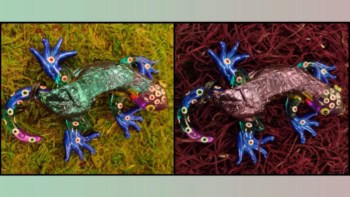Physicists at Glasgow University in the UK have observed for the first time the hidden colours that were recently predicted to exist in “dark light” (J Leach and M Padgett 2003 New J. Phys. 5 154). Dark light is produced when two or more beams of light interfere destructively and cancel each other out to form a spot that appears completely black to the human eye.

The phenomenon of dark light is closely associated with regions of space known as phase dislocations or singularities: these are regions where the phase of the light is not defined and can have any value between zero and 2π. If the phase singularity is a line that runs parallel to the axis of the beam it is known as an “optical vortex”.
In 2002, Michael Berry of Bristol University in the UK predicted that it should be possible to see various colour patterns in the vicinity of such a vortex (New J. Phys. 4 74; New J. Phys. 4 66). Jonathan Leach and Miles Padgett have now observed these effects in experiments at Glasgow.
Leach and Padgett produced a white-light vortex by shining light from a 200-watt tungsten halogen bulb through a “spatial light modulator” – a holographic diffraction grating made from liquid crystal. This modulator allowed them to produce a beam in which all the photons had the same orbital angular momentum, even though the beam contained many different wavelengths.
The researchers then passed the beam containing the vortex through a standard CCD-based colour camera that contained a red-blue-green colour response similar to that of the eye. Because the vortices are regions of zero light intensity, the chromatic effects predicted by theory are extremely subtle. Leach and Padgett magnified these effects by applying a special colour correction – or “chromascope” – to the image (see figure).
“The resulting image we detected was exactly that predicted by Berry,” Leach told PhysicsWeb. “We observed that the vortex position was marked by a distinct chromatic pattern with a red and blue transition across the vortex separated by a narrow area of purple with no green colour.”
The Glasgow team says that although the light vortex itself has limited practical applications, light with orbital angular momentum could find use in quantum communications. It can also be used to trap and rotate microscopic objects in “optical tweezers”.



